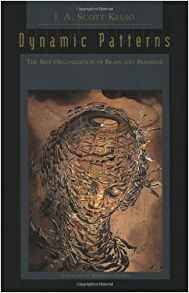Kelso, J.A., Scott. (1995). Dynamic patterns: The self-organization of brain and behavior. Cambridge, MA: The MIT Press. Paperback. ISBN 9780262611312.
 Available in paperback and hardcover.
Available in paperback and hardcover.
Paperback: 334 pages. Includes bibliographical references and index.
Reviewed by: Monica Spafford, New York University
We have utilized chaos theory as a model to explain the behavior of a variety of natural systems such as the climate. Chaos theory proposes that underneath the ‘chaotic’ behavior of a natural system lies patterns and self-organization. In recent decades, scientists have successfully applied chaos theory to clinical psychology. However, in Dynamic Patterns: The Self-Organization of Brain and Behavior, J.A. Scott Kelso seeks to explain the mathematical and physical underpinnings of chaos, self-organization, and non-linear systems and apply these concepts to the brain and behavior. He claims that there are unifying principles underlying all living things namely dynamic patterns, which provide the human body with stability, multifunctionality, and adaptability. Kelso opposes the neurophysiological and molecular biological approach to understanding brain structure and function because it focuses on individual neurons. He advocates for a different understanding of the brain and behavior, one that focuses on the cooperative behavior of neurons.
Kelso claims that the brain is self-organizing therefore spontaneous patterns form and change via nonlinear or dynamic interactions to coordinate brain activity and respond to the environment. He suggests by studying these patterns we can determine the laws that govern dynamic behavioral patterns, which can help us unpack more complex phenomena like perceiving, anticipating, and laughing. He supports his claims by citing the work of scientists like Herman Haken and reveals the variability of brain activities and its connection to behavior.
Through a revealing presentation of the findings of past experiments and astute analysis, Dynamic Patterns has received an endless amount of praise in the scientific community and is considered to be a landmark in the field of behavioral sciences and brain research. This book redefines self-organization and challenges readers to think about and question previously held notions about the brain and behavior. Additionally, the interdisciplinary nature of this book strengthens Kelso’s claims and suggests that information we already have may be more valuable than we originally thought if applied in different ways.
However, although informative, this book fails to discuss the application of chaos theory, self-organization, and nonlinear dynamics to psychotherapy and therefore maybe worth reading for clinicians seeking to learn about chaos theory as is relates specifically to clinical psychology.
J.A. Scott Kelso is Glenwood and Martha Creech Professor of Science and Co-Director of the Center for Complex Systems at Florida Atlantic University.
 Monica Spafford studies applied psychology at New York University and graduated May of 2018. She is a Research Assistant for the INSIGHTS into Children’s Temperament research study at NYU’s Institute of Human Development and Social Change testing the efficacy of the INSIGHTS program, an evidence-based intervention that works to support children’s social-emotional development and academic learning. In addition to working for Somatic Psychotherapy Today, she also writes reviews for the International Journal of Psychotherapy.
Monica Spafford studies applied psychology at New York University and graduated May of 2018. She is a Research Assistant for the INSIGHTS into Children’s Temperament research study at NYU’s Institute of Human Development and Social Change testing the efficacy of the INSIGHTS program, an evidence-based intervention that works to support children’s social-emotional development and academic learning. In addition to working for Somatic Psychotherapy Today, she also writes reviews for the International Journal of Psychotherapy.






